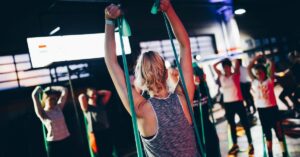Revolutionary Mobility Hacks That Can Prevent Injuries and Enhance Your Performance

Revolutionary Mobility Hacks That Can Prevent Injuries and Enhance Your Performance
As athletes and fitness enthusiasts, we are always on the hunt for that elusive edge—something that will elevate our performance and keep us in the game longer. It’s often said that the best athletes are not just born but made, and a significant part of that process involves mobility. But let’s be real for a second. How many of us have neglected those pesky flexibility drills? (I know I’ve skipped them more times than I care to admit.) However, recently, a new wave of mobility hacks has emerged, promising to revolutionize how we think about movement and injury prevention. This article will dive deep into these innovative strategies that could change not just how you perform, but how you feel while doing it.
Understanding Mobility: The Foundation of Performance
Before we get into the hacks, it’s crucial to understand what mobility really means. Mobility is not just flexibility—it’s about the ability to move freely and easily through your joints and muscles. Think of it as the oil in your car’s engine; without it, everything runs less smoothly. Whether you’re lifting weights, running marathons, or simply trying to play a game of pick-up basketball, good mobility is key to optimizing performance and minimizing injuries.
Now, consider this: a significant number of sports injuries arise from poor mobility. Tight hamstrings? Check. Stiff shoulders? Double check. This is where mobility hacks come into play. They can help you improve your range of motion, enhance your athletic performance, and—most importantly—keep you injury-free.
1. Dynamic Warm-Ups: The Game Changer
Let’s face it, warming up can feel like the most tedious part of working out. But dynamic warm-ups are not just a fancy term for stretching. These are a series of movements designed to get your blood flowing, joints lubricated, and muscles activated. You might be thinking, “But I can just do static stretching, right?” Well, not quite. Static stretching has its place, but it often doesn’t prepare your body for the rigors of sports or intense workouts.
Dynamic warm-ups involve moving parts of your body through their full range of motion. Here are some popular exercises you might want to incorporate:
- Leg swings (forward and sideways)
- Arm circles
- Walking lunges with a twist
- High knees and butt kicks
- Hip openers
Just imagine it: you’re at the gym, and instead of standing around, you’re grooving through these movements. Not only do you feel more energized, but you also reduce your risk of injury. It’s a win-win!
2. Foam Rolling: The Self-Massage Revolution
Ah, foam rolling—the love-it-or-hate-it of the fitness world. But listen, if you’re looking to improve your mobility, foam rolling should be your best friend. This technique helps break down fascial adhesions and tightness in your muscles, allowing them to move more freely. It’s like giving your body a nice, deep massage after a long day.
But don’t just roll around aimlessly. Here’s how to get the most out of your foam rolling sessions:
- Spend at least 30 seconds on each muscle group, focusing on areas that feel tight.
- Control your breathing—exhale as you roll over a particularly tight spot.
- Incorporate different types of foam rollers: smooth for gentler pressure, textured for deeper tissue work.
Even the pros swear by it. I remember chatting with a professional soccer player who told me that foam rolling was a non-negotiable part of his routine—almost like his morning coffee. And trust me, he wasn’t just saying that for the sake of it.
3. Mobility Drills: The Unsung Heroes
Mobility drills are often overlooked, yet they are incredibly effective for improving your range of motion. These exercises are designed to specifically target joint mobility and muscle flexibility. Think of them as the secret sauce to your performance-enhancing recipe. Some of my favorites include:
- Hip CARs (Controlled Articular Rotations)
- Shoulder dislocates with a resistance band
- World’s greatest stretch
- Spinal waves
- Toe touch to overhead reach
These drills can be done in as little as 10-15 minutes, and the results? Well, let’s just say it might feel like you’ve been given a new pair of legs.
4. Breathing Techniques: The Power of Breath
It might sound a bit too Zen, but the way you breathe can significantly impact your mobility. Yes, you read that right. Proper breathing techniques can help you relax tense muscles and improve your range of motion. Think about it: when you’re stressed or tense, your body naturally contracts. By focusing on your breath, you can counteract that.
One technique that’s gaining traction is diaphragmatic breathing. Here’s how to do it:
- Find a comfortable position, either sitting or lying down.
- Place one hand on your chest and the other on your belly.
- Breathe in deeply through your nose, allowing your belly to rise while keeping your chest relatively still.
- Exhale slowly through your mouth, feeling your belly fall.
Practice this for a few minutes each day, and you might just find yourself not only feeling calmer but also moving better. (I know, it sounds a bit like a yoga retreat, but bear with me.)
5. The Role of Nutrition: Fueling Mobility
It’s easy to overlook the role of nutrition in mobility, but your diet plays a pivotal role in how your body moves. Consuming anti-inflammatory foods can aid in recovery and improve joint function. Think of foods rich in omega-3 fatty acids, antioxidants, and vitamins. Here are some to consider:
- Fatty fish (like salmon)
- Nuts and seeds
- Leafy greens
- Fruits like berries and oranges
- Whole grains
Additionally, staying hydrated is essential. Water helps keep your muscles lubricated and functioning properly. Dehydration can lead to stiffness and cramps—definitely not what you want during a workout or competition!
6. Incorporating Yoga: Flexibility Meets Strength
Yoga isn’t just for those seeking inner peace; it’s a powerful tool for enhancing mobility and preventing injuries. Many athletes have started integrating yoga into their routines, and for good reason. The combination of strength, flexibility, and mindfulness can lead to improved performance.
Some yoga poses that are particularly beneficial for mobility include:
- Downward-facing dog
- Warrior II
- Cat-cow stretch
- Pigeon pose
- Bridge pose
Even if you’re not a yoga enthusiast, dedicating a few minutes post-workout to these poses can make a world of difference. It’s like giving your body a gentle reset after a tough training session.
7. Rest and Recovery: The Often-Overlooked Aspect
When we think about mobility, it’s easy to focus solely on the active aspects—stretching, rolling, and drilling, but let’s not forget the importance of rest and recovery. Allowing your body to recover is just as crucial as the training itself. Overtraining can lead to tight muscles and injuries, which is the opposite of what we want.
Incorporate active recovery days into your routine, which could include light activities like walking or swimming. And don’t underestimate the power of a good night’s sleep; it’s during this time that your body repairs and regenerates. (Trust me, I’ve seen too many athletes skimp on sleep, and it never ends well!)
8. Mind-Body Connection: Engage Your Brain
Here’s a thought: what if I told you that the way you think could impact your movement? It might sound a bit far-fetched, but research suggests that visualization techniques can enhance performance and mobility. Imagine yourself moving fluidly through your sport, or visualizing the muscles you want to engage during a specific exercise. Your brain can actually help activate those muscles.
Next time you’re gearing up for a workout or competition, take a few minutes to visualize your movements. Think about how it feels to move with ease and grace. You might be surprised at the results!
9. Tech Tools: The New Age of Mobility
In our tech-savvy world, it’s no surprise that gadgets and apps have entered the realm of mobility and performance enhancement. From wearables that track your movement patterns to apps that guide you through stretching routines, technology has made it easier than ever to monitor and improve your mobility.
Some popular tools include:
- Foam rollers with built-in vibration
- Stretching apps that offer guided routines
- Wearables that assess your movement quality
- Online classes focusing on mobility training
While some may be skeptical about the effectiveness of tech in fitness, I’ve seen firsthand how these tools can motivate individuals to stay on track and improve their mobility. Just remember, technology is meant to supplement your efforts, not replace them.
10. The Importance of Consistency
At the end of the day, the most revolutionary mobility hack isn’t a specific exercise or technique—it’s consistency. You won’t see results if you only stretch or roll out sporadically. Set aside dedicated time in your weekly routine for mobility work, and stick to it like you would a workout.
And here’s a little secret: make it enjoyable! Find exercises that you genuinely like, mix things up, or even join a class. The more fun you have, the more likely you are to stick with it.
Conclusion: The Path to Enhanced Performance
In a world where every second counts and every move matters, incorporating revolutionary mobility hacks into your routine can set you apart from the competition. From dynamic warm-ups to nutrition and tech tools, the strategies outlined here are designed to not only enhance your performance but to keep you injury-free.
So, the next time you think about skipping that stretching session or rolling out after a tough workout, remember the benefits that await you. Embrace these mobility hacks, and who knows? You may just find yourself moving like a well-oiled machine, ready to conquer whatever challenge comes your way.
As I reflect on my own journey as an athlete, I can’t help but think of how much I could have benefited from these insights earlier on. It’s never too late to start, though—so why not give it a shot today? Your body (and performance) will thank you!







